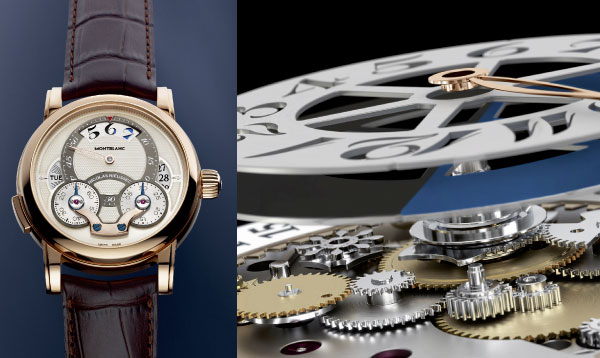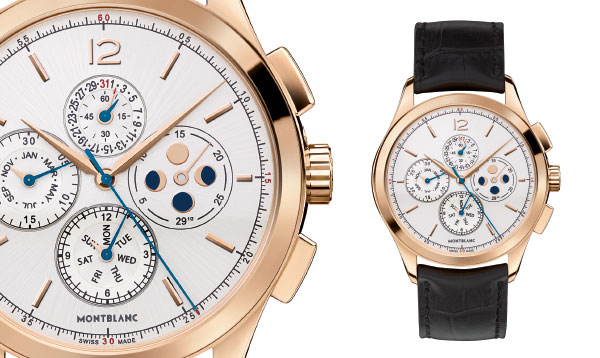
Nicolas Rieussec Rising Hour Chronograph
Case : steel, 18K red gold or 950 platinum (limited series), sapphire crystal back Diameter : 43mm Movement : mechanical self-winding (Calibre MB R2220, 72h power reserve), 343 parts, 2 barrels, column wheel and vertical coupling-clutch, circular-grained and rhodiumed bridges and plates Functions : hours, minutes, seconds, date, day/night, chronograph, power reserve display on the back Dial : silver-toned, barleycorn guilloché motif Water resistance : 30m Strap : brown (or black) alligator leather with triple folding clasp in 18K red gold (or steel or platinum) Limited series : 22-piece platinum version
For the first time, GMT is devoting its cover to a Montblanc timepiece. First launched in 2008, the Nicolas Rieussec chronograph collection pays tribute to the inventor of the “inking chronograph” patented in 1821. This year, the now immediately identifiable line welcomes the Nicolas Rieussec Rising Hour Chronograph, of which the new day/night mechanism is also patented. Available in boutiques by the time this magazine is published, this single-pusher chronograph with a self-winding in-house movement is also one of the watches selected in the Men’s watch category of the 2013 Geneva Watchmaking Grand Prix. While its digital hours indication by means of a small triangular index remains true to the classic models, this new version is distinguished by the change of colour of the hours scale according to the time of day. The 6 o’clock numeral thus appears in a pale blue tone on the left and a black shade on the right at 6 am, in order to symbolise the end of the night and the dawn of a new day, whereas at 6 pm the black colour on the left indicates that the day is drawing to a close, while the blue-tinted night hours are preparing to enter the dance. This patented system is based on two rotating discs positioned one on top of the other (one with the numerals and the other with pale blue and black segments) linked to two cams and controlled by a Maltese cross mechanism. Their profile is shaped to ensure that the discs remain motionless between 9 am and 3 pm and between 9 pm and 3 am. The meshing process begins at 3 am and 3 pm, causing the day/night disc to accelerate until the two teeth on either side engage between 4.30 am and 7 am, and from 4.30 pm to 7 pm. All of which does much to explain why this model is aptly named Rising Hours! On the four dial discs highlighted by a barleycorn guilloché pattern, the owner of this timepiece can easily keep track of the time measured (on 60-second and 30-minute counters), the day of the week (at 9 o’clock) and the date (at 3 o’clock). The chronograph is activated in a user-friendly manner by a pusher at 8 o’clock, while the power-reserve is displayed on the back of the steel, gold and platinum case, along with circular-grained and rhodiumed bridges and plates adorned with a Côtes de Genève motif. The Montblanc watchmakers can legitimately lay claim to have reached new peaks of achievement.






